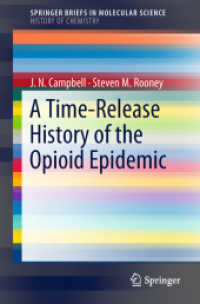- ホーム
- > 洋書
- > 英文書
- > Philosophy
Full Description
Providing a gateway to a new history of modern aesthetics, this book challenges conventional views of how art's significance developed in society.
The 18th century is often said to have involved a radical transformation in the concept of art: from the understanding that it has a practical purpose to the modern belief that it is intrinsically valuable. By exploring the ground between these notions of art's function, Karl Axelsson reveals how scholars of culture made taste, morals and a politically stable society integral to their claims about the experience of nature and art.
Focusing on writings by two of the most prolific men of letters in the 18th century, Joseph Addison (1672-1719) and the third Earl of Shaftesbury (1671-1713), Axelsson contests the conviction that modern aesthetic autonomy reoriented the criticism and philosophy originally prompted by these two key figures in the history of aesthetics.
By re-examining the political relevance of Addison and Shaftesbury's theories of taste, Axelsson shows that first and foremost they sought to fortify a natural link between aesthetic experience and modern political society.
Contents
Acknowledgements
Note to the Reader
Introduction
Rethinking a Provenance
Reading the History of Aesthetics
Addison and the Body Politic
Shaftesbury, Affections, and Society
Part I: Addison, Taste, and the Moral Body Politic
1.1 The Displacement of Political Authority
1.2 The Disposition of Taste
1.3 Aurelia and Fulvia
1.4 Ethico-Emotive Pleasures
1.5 Faith and Political Enthusiasm
1.6 Britain and the New Classicism
1.7 The Perils of the Foreign
Part II: Moved by Affections: Shaftesbury on Beauty and Society
2.1 Natural Affections
2.2 Self-Knowledge and Disinterestedness
2.3 A Disinterested (Aesthetic) Perception
2.4 The Work of Art as a Whole
2.5 Taste for Society
Coda: Reading Addison and Shaftesbury in the Future
Bibliography
Index








